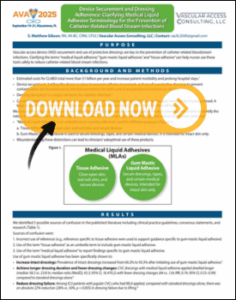
From Confusion to Clarity: Shedding Light on Adhesive Terminology in Vascular Access
At the AVA 2025 Annual Scientific Meeting, vascular access expert Matt Gibson, RN, VA-BC, CRNI, CPUI, addressed an issue that many clinicians face daily but rarely pause to examine: adhesives.
His poster, “Device Securement and Dressing Adherence: Clarifying Medical Liquid Adhesive Terminology for the Prevention of Catheter-Related Bloodstream Infections,” revealed how something as simple as a misunderstanding of adhesive terminology can put patients at risk.
Why Dressings Matter More Than We Think
Gibson began by showing a photo of a poorly secured catheter dressing—an image familiar to many nurses. “The dressing is part of the securement,” he explained. “It’s not just to cover. It helps stabilize the catheter and prevent infection.”
This point is critical because research shows dressing disruption is a single, independent risk factor for catheter-related bloodstream infections (CLABSIs). Each additional dressing change increases infection risk exponentially. Yet, as Gibson noted, while policies often call for dressing changes every seven days, studies reveal that three-quarters of dressings fail within 48 hours.
Sorting Out the Terminology
Much of the confusion stems from inconsistent language across guidelines, consensus statements, and research. Gibson’s review identified three key terms that are often conflated:
- Medical Liquid Adhesive (MLA): the umbrella category.
- Tissue Adhesive: used to close skin, seal insertion sites, and add securement at the hub.
- Gum Mastic Liquid Adhesive: applied around the edges of a dressing to make it more durable, intended only for intact skin.
These distinctions matter. Using the wrong product—or citing the wrong evidence—can lead to suboptimal or unsafe practice. For example, tissue adhesive should never be applied like gum mastic to the dressing border, and gum mastic should never be used as a sealant at the insertion site.
Evidence for Gum Mastic
The data supporting gum mastic is compelling. Gibson highlighted studies showing:
- Improved dressing integrity: intact dressings increased from 60% to 93% after gum mastic adoption.
- Longer dwell times: median dressing life extended from 23.8 to 58.5 hours.
- Reduced failure rates: ICU patients with jugular CVCs saw a 22% absolute reduction in dressing failure compared to dressings alone.
As Gibson put it, “In seven seconds, you can save a dressing for seven days.” The benefits extend beyond infection prevention: fewer dressing changes mean less nurse workload, fewer supplies used, and improved patient comfort.
Watch the Full Session
Hear Matt explain the terminology, evidence, and implications in a recording from his brief AVA presentation.
A Call for Clarity and Consistency
Ultimately, Gibson’s message was simple but powerful: words matter. “We don’t want to use products in ways they weren’t intended,” he emphasized. Clear terminology in research, guidelines, and practice can help clinicians select the appropriate adhesive, apply it correctly, and minimize the risk of CLABSI.
For hospitals, this means revisiting policies, educating staff, and partnering with manufacturers to audit outcomes. The cost savings and safety improvements, Gibson argued, are well worth the effort.
Eloquest Healthcare is committed to providing solutions that help improve vascular access dressing securement and decrease complications while reducing unnecessary costs. Mastisol® Liquid Adhesive is designed to enhance dressing adherence and minimize the risk of infection.
For more information about Mastisol®, please call 1‐877‐433‐7626 or complete this form.









